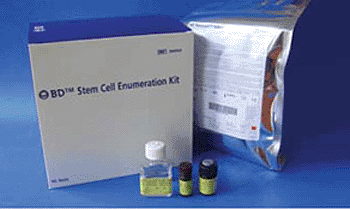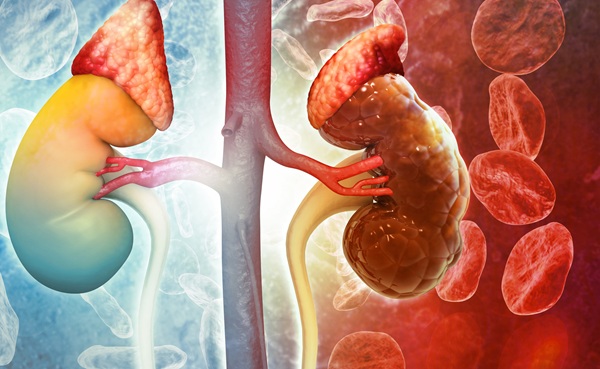Flow Cytometry Stem Cell Enumeration Kit Designed to Ease Stem Cell Transplantation
|
By LabMedica International staff writers Posted on 07 Mar 2012 |

Image: The BD Stem Cell Enumeration (SCE) Kit (Photo courtesy of BD Biosciences).
A dedicated flow cytometry stem cell enumeration kit is aimed at the rapidly growing stem cell transplantation market.
High-dose chemotherapy (HDC) with transplant is now standard therapy in multiple myeloma, acute myeloid leukemia in first remission, and intermediate-grade non-Hodgkin's lymphoma. Stem cell transplantation with cell selection is performed after HDC in an effort to restore a cancer patient’s blood and immune cell production capacity, which is destroyed in this aggressive form of cancer treatment. Improvements in transplantation techniques, including the wider use of cell selection, have also contributed to a significant reduction in the morbidity and mortality associated with conventional transplantation. As a result, HDC with transplantation has grown at an average annual rate of 21% over the past 10 years.
To aid clinicians and researchers working in the stem cell transplantation field BD Biosciences (Franklin Lakes, NJ, USA) has introduced their BD Stem Cell Enumeration (SCE) Kit for use on the BD FACSCanto II and BD FACSCalibur flow cytometers.
The SCE Kit is for in vitro diagnostic use and provides a single-tube, single-platform assay for accurate, reproducible, and rapid enumeration of CD34+ hematopoietic and progenitor cells in a wide range of stem cell sources. Sample types that may be analyzed with the SCE Kit include normal and mobilized peripheral blood, material from fresh or frozen leukophoresis, bone marrow, and cord blood.
The BD SCE assay allows simultaneous enumeration of total viable dual-positive CD45+/CD34+ hematopoietic stem cells in absolute counts of CD34+ cells/microliter and the percentage of viable leucocytes (CD45+) that are CD34-positive (CD34+). A set of premixed antibodies reduces reagent preparation time to meet productivity demands of clinical labs. In addition, the SCE assay incorporates BD’s proprietary Trucount tubes, which allow determination of absolute cell count, thereby eliminating variability associated with hematology-derived absolute counts.
Related Links:
BD Biosciences
High-dose chemotherapy (HDC) with transplant is now standard therapy in multiple myeloma, acute myeloid leukemia in first remission, and intermediate-grade non-Hodgkin's lymphoma. Stem cell transplantation with cell selection is performed after HDC in an effort to restore a cancer patient’s blood and immune cell production capacity, which is destroyed in this aggressive form of cancer treatment. Improvements in transplantation techniques, including the wider use of cell selection, have also contributed to a significant reduction in the morbidity and mortality associated with conventional transplantation. As a result, HDC with transplantation has grown at an average annual rate of 21% over the past 10 years.
To aid clinicians and researchers working in the stem cell transplantation field BD Biosciences (Franklin Lakes, NJ, USA) has introduced their BD Stem Cell Enumeration (SCE) Kit for use on the BD FACSCanto II and BD FACSCalibur flow cytometers.
The SCE Kit is for in vitro diagnostic use and provides a single-tube, single-platform assay for accurate, reproducible, and rapid enumeration of CD34+ hematopoietic and progenitor cells in a wide range of stem cell sources. Sample types that may be analyzed with the SCE Kit include normal and mobilized peripheral blood, material from fresh or frozen leukophoresis, bone marrow, and cord blood.
The BD SCE assay allows simultaneous enumeration of total viable dual-positive CD45+/CD34+ hematopoietic stem cells in absolute counts of CD34+ cells/microliter and the percentage of viable leucocytes (CD45+) that are CD34-positive (CD34+). A set of premixed antibodies reduces reagent preparation time to meet productivity demands of clinical labs. In addition, the SCE assay incorporates BD’s proprietary Trucount tubes, which allow determination of absolute cell count, thereby eliminating variability associated with hematology-derived absolute counts.
Related Links:
BD Biosciences
Latest BioResearch News
- Genome Analysis Predicts Likelihood of Neurodisability in Oxygen-Deprived Newborns
- Gene Panel Predicts Disease Progession for Patients with B-cell Lymphoma
- New Method Simplifies Preparation of Tumor Genomic DNA Libraries
- New Tool Developed for Diagnosis of Chronic HBV Infection
- Panel of Genetic Loci Accurately Predicts Risk of Developing Gout
- Disrupted TGFB Signaling Linked to Increased Cancer-Related Bacteria
- Gene Fusion Protein Proposed as Prostate Cancer Biomarker
- NIV Test to Diagnose and Monitor Vascular Complications in Diabetes
- Semen Exosome MicroRNA Proves Biomarker for Prostate Cancer
- Genetic Loci Link Plasma Lipid Levels to CVD Risk
- Newly Identified Gene Network Aids in Early Diagnosis of Autism Spectrum Disorder
- Link Confirmed between Living in Poverty and Developing Diseases
- Genomic Study Identifies Kidney Disease Loci in Type I Diabetes Patients
- Liquid Biopsy More Effective for Analyzing Tumor Drug Resistance Mutations
- New Liquid Biopsy Assay Reveals Host-Pathogen Interactions
- Method Developed for Enriching Trophoblast Population in Samples
Channels
Clinical Chemistry
view channel
POC Breath Diagnostic System to Detect Pneumonia-Causing Pathogens
Pseudomonas aeruginosa is a major cause of hospital-acquired and ventilator-associated pneumonia, particularly in lung transplant recipients and patients with structural lung disease. Its ability to form... Read more
Online Tool Detects Drug Exposure Directly from Patient Samples
Doctors often rely on patient interviews and medical records to determine what medications a person has taken, but this information is frequently incomplete. People may forget drugs they used, take over-the-counter... Read moreMolecular Diagnostics
view channel
Blood Biomarker Improves Early Brain Injury Prognosis After Cardiac Arrest
After a cardiac arrest, many patients remain unconscious for days, leaving doctors and families facing uncertainty about whether meaningful recovery is possible. Current tools to assess brain damage, including... Read more
Biomarkers Could Identify Patients at High Risk of Severe AKI After Major Surgery
Acute kidney injury is one of the most common and dangerous complications after major surgery, particularly among patients in intensive care. Even mild impairment of kidney function can lead to long-term... Read more
CLIA Test Identifies Head and Neck Cancer Recurrence from Post-Surgical Lymphatic Fluid
While the lymphatic system’s critical role in metastasis has long been recognized, routine access to patient lymph has been elusive. Now, a non-invasive process can access lymph through the collection... Read moreHematology
view channel
MRD Tests Could Predict Survival in Leukemia Patients
Acute myeloid leukemia is an aggressive blood cancer that disrupts normal blood cell production and often relapses even after intensive treatment. Clinicians currently lack early, reliable markers to predict... Read more
Platelet Activity Blood Test in Middle Age Could Identify Early Alzheimer’s Risk
Early detection of Alzheimer’s disease remains one of the biggest unmet needs in neurology, particularly because the biological changes underlying the disorder begin decades before memory symptoms appear.... Read more
Microvesicles Measurement Could Detect Vascular Injury in Sickle Cell Disease Patients
Assessing disease severity in sickle cell disease (SCD) remains challenging, especially when trying to predict hemolysis, vascular injury, and risk of complications such as vaso-occlusive crises.... Read more
ADLM’s New Coagulation Testing Guidance to Improve Care for Patients on Blood Thinners
Direct oral anticoagulants (DOACs) are one of the most common types of blood thinners. Patients take them to prevent a host of complications that could arise from blood clotting, including stroke, deep... Read moreImmunology
view channelBlood Test Could Detect Adverse Immunotherapy Effects
Immune checkpoint inhibitors have transformed cancer treatment, but they can also trigger serious immune-related adverse events that damage healthy organs and may become life-threatening if not detected early.... Read more
Routine Blood Test Can Predict Who Benefits Most from CAR T-Cell Therapy
CAR T-cell therapy has transformed treatment for patients with relapsed or treatment-resistant non-Hodgkin lymphoma, but many patients eventually relapse despite an initial response. Clinicians currently... Read moreMicrobiology
view channel
Blood-Based Diagnostic Method Could Identify Pediatric LRTIs
Lower-respiratory tract infections (LRTIs) are a leading cause of illness and death worldwide, and pneumonia is the leading infectious cause of death in children under five, claiming the lives of over... Read more
Rapid Diagnostic Test Matches Gold Standard for Sepsis Detection
Sepsis kills 11 million people worldwide every year and generates massive healthcare costs. In the USA and Europe alone, sepsis accounts for USD 100 billion in annual hospitalization expenses.... Read moreRapid POC Tuberculosis Test Provides Results Within 15 Minutes
Tuberculosis remains one of the world’s deadliest infectious diseases, and reducing new cases depends on identifying individuals with latent infection before it progresses. Current diagnostic tools often... Read more
Rapid Assay Identifies Bloodstream Infection Pathogens Directly from Patient Samples
Bloodstream infections in sepsis progress quickly and demand rapid, precise diagnosis. Current blood-culture methods often take one to five days to identify the pathogen, leaving clinicians to treat blindly... Read morePathology
view channel
Rapid Low-Cost Tests Can Prevent Child Deaths from Contaminated Medicinal Syrups
Medicinal syrups contaminated with toxic chemicals have caused the deaths of hundreds of children worldwide, exposing a critical gap in how these products are tested before reaching patients.... Read more
Tumor Signals in Saliva and Blood Enable Non-Invasive Monitoring of Head and Neck Cancer
Head and neck cancers are among the most aggressive malignancies worldwide, with nearly 900,000 new cases diagnosed each year. Monitoring these cancers for recurrence or relapse typically relies on tissue... Read more
Common Health Issues Can Influence New Blood Tests for Alzheimer’s Disease
Blood-based tests for Alzheimer’s disease are transforming diagnosis by offering a simpler alternative to spinal taps and brain imaging. However, many people evaluated at memory clinics also live with... Read more
Blood Test Formula Identifies Chronic Liver Disease Patients with Higher Cancer Risk
Chronic liver disease affects millions worldwide and can progress silently to hepatocellular carcinoma (HCC), one of the deadliest cancers globally. While surveillance guidelines exist for patients with... Read moreTechnology
view channel
Machine Learning Models Diagnose ALS Earlier Through Blood Biomarkers
Amyotrophic lateral sclerosis (ALS) is a rapidly progressive neurodegenerative disease that is notoriously difficult to diagnose in its early stages. Early symptoms often overlap with other neurological... Read more
Artificial Intelligence Model Could Accelerate Rare Disease Diagnosis
Identifying which genetic variants actually cause disease remains one of the biggest challenges in genomic medicine. Each person carries tens of thousands of DNA changes, yet only a few meaningfully alter... Read moreIndustry
view channel
BD and Penn Institute Collaborate to Advance Immunotherapy through Flow Cytometry
BD (Becton, Dickinson and Company, Franklin Lakes, NJ, USA) has entered into a strategic collaboration with the Institute for Immunology and Immune Health (I3H, Philadelphia, PA, USA) at the University... Read more







 assay.jpg)












